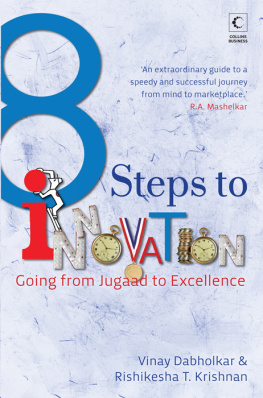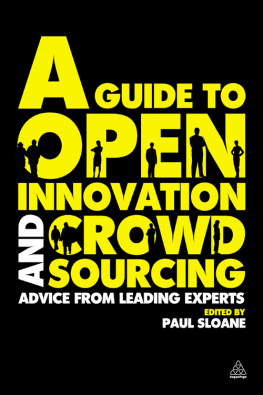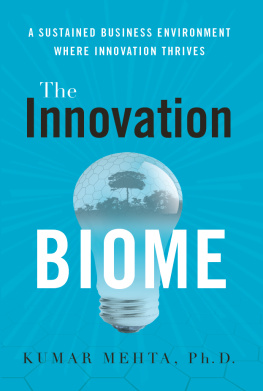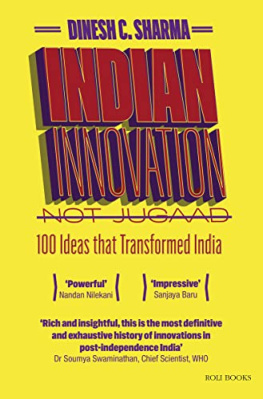8 STEPS TO
INNOVATION
Going from Jugaad to Excellence
VINAY DABHOLKAR
RISHIKESHA T. KRISHNAN

For my parents
Padmakar and Usha
Vinay
Contents
Once your mind stretches to a new level, it never goes back to its original dimension
A.P.J. Abdul Kalam
- Indias new symbol for the rupee was designed by D. Udaya Kumar, an architect-turned designer from Tamil Nadu. Kumars main interest is in Tamil typography, but his moment of fame came in 2010 when the symbol he designedintegrating the best of international design creativity with a distinctive Indian flavourwas accepted by the Reserve Bank of India.
- Thiyagarajan Ramaswamy, an engineering student, and son of a Pondicherry-based weaver, reworked the design of commercially available wet-grinders (used to make batter for idlis, a south Indian rice cake) so that his mother could make idlis as soft as the ones made from a traditional hand-ground batter. His design
- Anandraj Sengupta became the first young Indian to be featured on the cover of the prominent international business magazine Businessweek in 2003, as an icon of Indias emerging strength in technology and innovation. An employee of General Electrics John F. Welch Technology Centre, the largest multidisciplinary multinational research and development (R&D) centre in India, Anandraj was well known for his system-level innovations, including his contribution to a new method to enhance the effectiveness of rail track inspections using ultrasound transducers, which was awarded a US patent.
- Anand Kumar, then a mathematics student at Patna University, started the Ramanujam School of Mathematics in 1992 to further his love for mathematics. When Anand was unable to take up a scholarship to attend Cambridge University because of his poor financial condition, he used the Ramanujam School to train poor but talented students for competitive examinations. Since 2003, Anand has selected thirty poor and talented students every year and trained them for the joint entrance examination (JEE) to Indias prestigious Indian Institutes of Technology (IITs). In the last eight years, 212 of the 240 Super 30 students have qualified for admission to the IITs.
- An innovation by factory employees participating in various programmes in the Innovation School of Management at Titan Industries jewellery manufacturing division has led to deskilling of the mould-setting process, a cumulative savings of Rs 43 crore and the Tata Groups award for the best innovation.
Everyone can fly, promised low-cost aviation pioneer Captain Gopinath, and the examples given in the box suggest that there is much more that everyone can doperhaps anyone can innovate. Maybe, you might be thinking, as long as the conditions are right. Can we create organizations that can provide support for innovation? Are there ways in which organizations can ensure a steady stream of innovations? Is it possible to promote systematic innovation?
An emphatic yes is the answer to all these questions. Read on, to find out how.
In 1959, the Hindustan Machine Tools (HMT) Factory in Bengaluru started the assembly of radial drilling machines mainly out of imported components from Kolb in Cologne, Germany. Dr S.M. Patil, who would later go on to become the chief executive officer and managing director, was a general manager then. In 1960, when the manufacture of the machines was indigenized, the machines started making jerky noises while ascending and descending.
It was found that a worn-out screw was causing the malfunctioning. A workaround was devised and implemented, which only served to increase the customer complaints. The unit was assigned to expert assemblers yet the defect persisted. In fact, the rate of failure increased and one in five machines started getting stuck. Eventually, an assembly foreman of the same section was sent to Kolb to study the methods followed there. After three weeks the foreman returned, confident that he could fix the problem. The confidence didnt last long as he realized that the problem persisted even after close monitoring of the assembly process.
One day in 1961, Patil was taking a walk through the shop floor when the foreman of the heavy parts planning sectionlets call him Rajappatold him that he had a solution for the problem. Rajappa also requested Patil to allow him to demonstrate his idea through a few prototypes. Patil gave him a chance despite resistance from the section managers. Rajappa designed a simple solution. He made sure that the arm that was carried throughout the assembly was always placed vertically. The simple solution solved the problem permanently. Rajappa was promoted to a deputy managers position.
writes the story more as a digression. After all, it is a story where nothing earth-shattering happened. No new product or service was created. It didnt reverse a trend of deserting customers. In the 1960s, it is quite likely that even if customers wanted to desert, they wouldnt have been able to since they didnt have too many options.
We consider this story an important early example of innovation because in this case we have an idea and its implementation that resulted in the improvement of an important parameter: product quality.
Lets compare this story with one that happened in a town called Jamshedpur, about a couple of thousand kilometres away from Bengaluru, around the same time as the RajappaPatil chance meeting.
P.K. Chakraborty, then charge-man in the Loco Shops at Tata Engines and Locomotives Company (Telco, now Tata Motors) gave a suggestion to the works manager.
Rajappa and Chakrabortys stories reinforce the idea that anyone can innovate. But they differ in an important way. Unlike HMT, Telco went ahead and turned the insight that ideas can come from anybodyeven shop-floor workersinto a process called the suggestion box scheme that was rolled out in 1959. Tisco (now Tata Steel) started a suggestion scheme even earlier in 1932 though it was formalized as a suggestion box in 1945.
Through a typical suggestion box scheme, the management invites ideas from employees on how to improve things in the workplace. On a regular basis, say once a month, ideas are evaluated by a committee and some ideas are implemented. A suggestion scheme has an associated incentive scheme where people who submit ideas and/or those whose ideas are implemented get rewarded.
When innovation happens in the organization only through ad hoc means and chance meetings like that between Rajappa and Patil, it seems more like jugaad. The word has its origin in north India where transportation vehicles are made by sourcing locally available parts, including the engine. We can call it ad hoc creative improvisation as well. On the other hand, when an organization has a disciplined way of generating, selecting, nurturing and implementing ideas, like the suggestion scheme of Telco, we call it systematic innovation.
This is a book to help managers steer their organization from jugaad to systematic innovation. Before we explore the other dimensions of systematic innovation, lets clarify what we mean by innovation itself.
Innovation happens when an idea is implemented to create an impact. It has three elements: idea, implementation and impact. In a for-profit organization, the impact is typically measured as either cost saving or as an increase in revenuesboth resulting in higher profits. We have already seen two examples of cost saving that originated as ideas from Rajappa and Chakraborty. An innovation also happens when a new phone model is launched by a Nokia or an Apple or a Micromax and results in profits.










